Plastic Zone Radius Criteria for Crack Propagation Angle Evaluated with Experimentally Obtained Displacement Fields
Abstract
1. Introduction
2. Criteria for the Crack Path
3. Materials and Methods
4. Results and Discussion
4.1. CP Prediction for Modified C(T)
4.2. CP Prediction for SENT Samples
4.3. Discussion
5. Conclusions
Author Contributions
Funding
Data Availability Statement
Conflicts of Interest
Acronyms and Nomenclature
| Plastic zone | PZ |
| Crack path | CP |
| Single edge notch tension | SENT |
| Compact test | C(T) |
| Linear elastic fracture mechanics | LEFM |
| Floating-point operations | FLOPS |
| Increment in crack kinking angle | Δθ |
| Stress intensity factor | SIF, K |
| Equivalent stress intensity factor | Keq |
| Stress intensity factor range factor | ΔK |
| Plastic zone radius | Pzr. |
| Fatigue threshold | ΔKth |
| Digital image correlation | DIC |
| Finite element modeling | FEM |
| Applied force | F |
| Normal stress | σ |
| Shear stress | τ |
| Radial direction | r |
| Tangential direction | θ |
| Yield stress | σy |
| Poisson’s modulus | ν |
| Residual ligament size | (a/W) |
| Measure crack kinking angle | θexp |
| Predicted crack kinking angle | θ* |
References
- Mróz, K.P.; Mróz, Z. On Crack Path Evolution Rules. Eng. Fract. Mech. 2010, 77, 1781–1807. [Google Scholar] [CrossRef]
- Yu, X.; Li, L.; Proust, G. Fatigue Crack Growth of Aluminium Alloy 7075-T651 under Proportional and Non-Proportional Mixed Mode I and II Loads. Eng. Fract. Mech. 2017, 174, 155–167. [Google Scholar] [CrossRef]
- Kujawski, D. Discussion and Comments on KOP and ∆Keff. Materials 2020, 13, 4959. [Google Scholar] [CrossRef]
- Kibey, S.; Sehitoglu, H.; Pecknold, D.A. Modeling of Fatigue Crack Closure in Inclined and Deflected Cracks. Int. J. Fract. 2004, 129, 279–308. [Google Scholar] [CrossRef]
- Vormwald, M.; Hos, Y.; Freire, J.L.F.; Gonzáles, G.L.G.; Díaz, J.G. Crack Tip Displacement Fields Measured by Digital Image Correlation for Evaluating Variable Mode-Mixity during Fatigue Crack Growth. Int. J. Fatigue 2018, 115, 53–66. [Google Scholar] [CrossRef]
- Maneschy, J.E.; Miranda, C.A.d.J. Application of Fracture Mechanics in the Nuclear Industry, 1st ed.; Eletrobras: Rio de Janeiro, Brazil, 2023; ISBN 9788599092026. [Google Scholar]
- Worthington, M.; Chew, H.B. Crack Path Predictions in Heterogeneous Media by Machine Learning. J. Mech. Phys. Solids 2023, 172, 105188. [Google Scholar] [CrossRef]
- Wasiluk, B.; Golos, K. Prediction of Crack Growth Direction under Plane Stress for Mixed-Mode I and II Loading. Fatigue Fract. Eng. Mater. Struct. 2000, 23, 381–386. [Google Scholar] [CrossRef]
- Vormwald, M.; Hertel, O.; Zerres, P. Fatigue of Engineering Structures under Combined Nonproportional Loads: An Overview. Fatigue Fract. Eng. Mater. Struct. 2018, 41, 1449–1468. [Google Scholar] [CrossRef]
- Highsmith, S. Crack Path Determination for Non-Proportional Mixed-Mode Fatigue; Georgia University of Technology: Atlanta, GA, USA, 2009. [Google Scholar]
- Toribio, J.; Matos, J.C.; Gonzalez, B. Numerical Modeling of Plasticity-Induced Fatigue Crack Growth Retardation Due to Deflection in the Near-Tip Area. Metals 2021, 11, 541. [Google Scholar] [CrossRef]
- Rozumek, D.; Macha, E. A Survey of Failure Criteria and Parameters in Mixed-Mode Fatigue Crack Growth. Mater. Sci. 2009, 45, 190–210. [Google Scholar] [CrossRef]
- Zhu, X.K.; Joyce, J. Review of Fracture Toughness (G, K, J, CTOD, CTOA) Testing and Standardization. Eng. Fract. Mech. 2012, 85, 1–46. [Google Scholar] [CrossRef]
- Wang, Y.; Wang, W.; Zhang, B.; Li, C.-Q. A Review on Mixed Mode Fracture of Metals. Eng. Fract. Mech. 2020, 235, 107126. [Google Scholar] [CrossRef]
- Ren, L.; Zhu, Z.; Wang, M.; Zheng, T.; Ai, T. Mixed-Mode Elastic-Plastic Fractures: Improved R-Criterion. J. Eng. Mech. 2014, 140, 04014033. [Google Scholar] [CrossRef]
- Richard, H.A.; Fulland, M.; Sander, M. Theoretical Crack Path Prediction. Fatigue Fract. Eng. Mater. Struct. 2005, 28, 3–12. [Google Scholar] [CrossRef]
- Vormwald, M.; Hos, Y.; Freire, J.L.F.; Gonzáles, G.L.G.; Díaz, J.G. Variable Mode-Mixity during Fatigue Cycles—Crack Tip Parameters Determined from Displacement Fields Measured by Digital Image Correlation. Frat. Ed Integrità Strutt. 2017, 11, 314–322. [Google Scholar] [CrossRef]
- Blanco, E.; Martínez, M.; González, J.; González, M. Fatigue Crack Growth Numerical Analysis of CPVC: Effect of Temperature and Load Frequency. Rev. UIS Ing. 2019, 18, 177–186. [Google Scholar] [CrossRef]
- Fageehi, Y.A.; Alshoaibi, A.M. Investigating the Influence of Holes as Crack Arrestors in Simulating Crack Growth Behavior Using Finite Element Method. Appl. Sci. 2024, 14, 897. [Google Scholar] [CrossRef]
- Berrios-Barcena, D.R.; Franco-Rodríguez, R.; Rumiche-Zapata, F.A. Calibration of Nasgro Equation for Mixed-Mode Loading Using Experimental and Numerical Data. Rev. Fac. De Ing. Univ. De Antioq. 2019, 97, 65–77. [Google Scholar] [CrossRef]
- Shahani, A.R.; Shakeri, I.; Rans, C.D. Fatigue Crack Growth of Al 5083-H111 Subjected to Mixed-Mode Loading. J. Braz. Soc. Mech. Sci. Eng. 2020, 42, 442. [Google Scholar] [CrossRef]
- Chatzigeorgiou, A.; Theotokoglou, E.; Tsamasphyros, G.I. Code Development for the Computational Analysis of Crack Propagation in Structures. Frat. Ed Integrità Strutt. 2020, 14, 306–324. [Google Scholar] [CrossRef]
- Pierson, K.; Rahman, A.; Spear, A.D. Predicting Microstructure-Sensitive Fatigue-Crack Path in 3D Using a Machine Learning Framework. JOM 2019, 71, 2680–2694. [Google Scholar] [CrossRef]
- Ricoeur, A.; Lindner, F.; Zarjov, K. Stochastic Aspects of Crack Deflection and Crack Path Prediction in Short Fiber Reinforced Polymer Matrix Composites. Eur. J. Mech.—A/Solids 2022, 95, 104598. [Google Scholar] [CrossRef]
- Díaz-Rodríguez, J.G.; Gonzales, G.L.; Ortiz Gonzalez, J.A.; Freire, J.L.d.F. Analysis of Mixed-Mode Stress Intensity Factors Using Digital Image Correlation Displacement Fields. In Proceedings of the 24th ABCM International Congress of Mechanical Engineering, Curitiba, Brazil, 3–8 December 2017; ABCM: Curitiba, Brazil, 2017. [Google Scholar]
- Merah, N.; Albinmousa, J. Experimental and Numerical Determination of Mixed Mode Crack Extension Angle. J. Test. Eval. 2009, 37, 95–107. [Google Scholar] [CrossRef]
- Pook, L.P. The Effect of Crack Angle on Fracture Toughness. Eng. Fract. Mech. 1971, 3, 205–218. [Google Scholar] [CrossRef]
- Aliha, M.R.M.; Berto, F.; Mousavi, A.; Razavi, S.M.J. On the Applicability of ASED Criterion for Predicting Mixed Mode I+II Fracture Toughness Results of a Rock Material. Theor. Appl. Fract. Mech. 2017, 92, 198–204. [Google Scholar] [CrossRef]
- Miranda, A.C.O.; Meggiolaro, M.A.; De Castro, J.T.P.; Martha, L.F. Fatigue Life Prediction of Complex 2D Components under Mixed-Mode Variable Amplitude Loading. Int. J. Fatigue 2003, 25, 1157–1167. [Google Scholar] [CrossRef]
- Sutton, M.A.; Orteu, J.J.; Schreier, H. Image Correlation for Shape, Motion and Deformation Measurements: Basic Concepts, Theory and Applications; Springer: Boston, MA, USA, 2009; ISBN 978-0-387-78746-6. [Google Scholar]
- Díaz, J.G.; Freire, J.L.d.F. LEFM Crack Path Models Evaluation under Proportional and Non-Proportional Load in Low Carbon Steels Using Digital Image Correlation Data. Int. J. Fatigue 2022, 156, 106687. [Google Scholar] [CrossRef]
- Atkinson, L. A Simple Benchmark of Various Math Operations. Available online: https://latkin.org/blog/2014/11/09/a-simple-benchmark-of-various-math-operations/ (accessed on 2 November 2023).
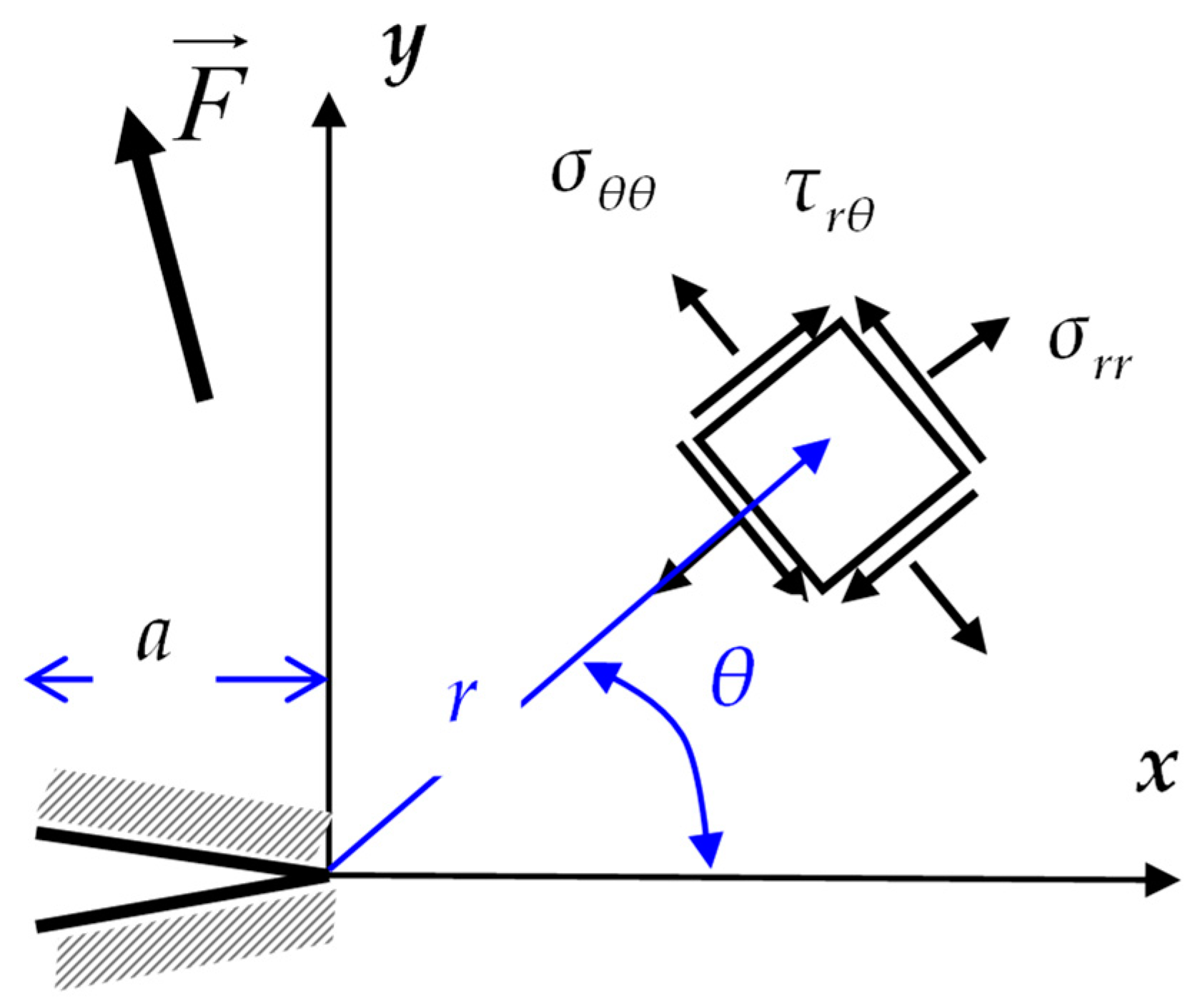


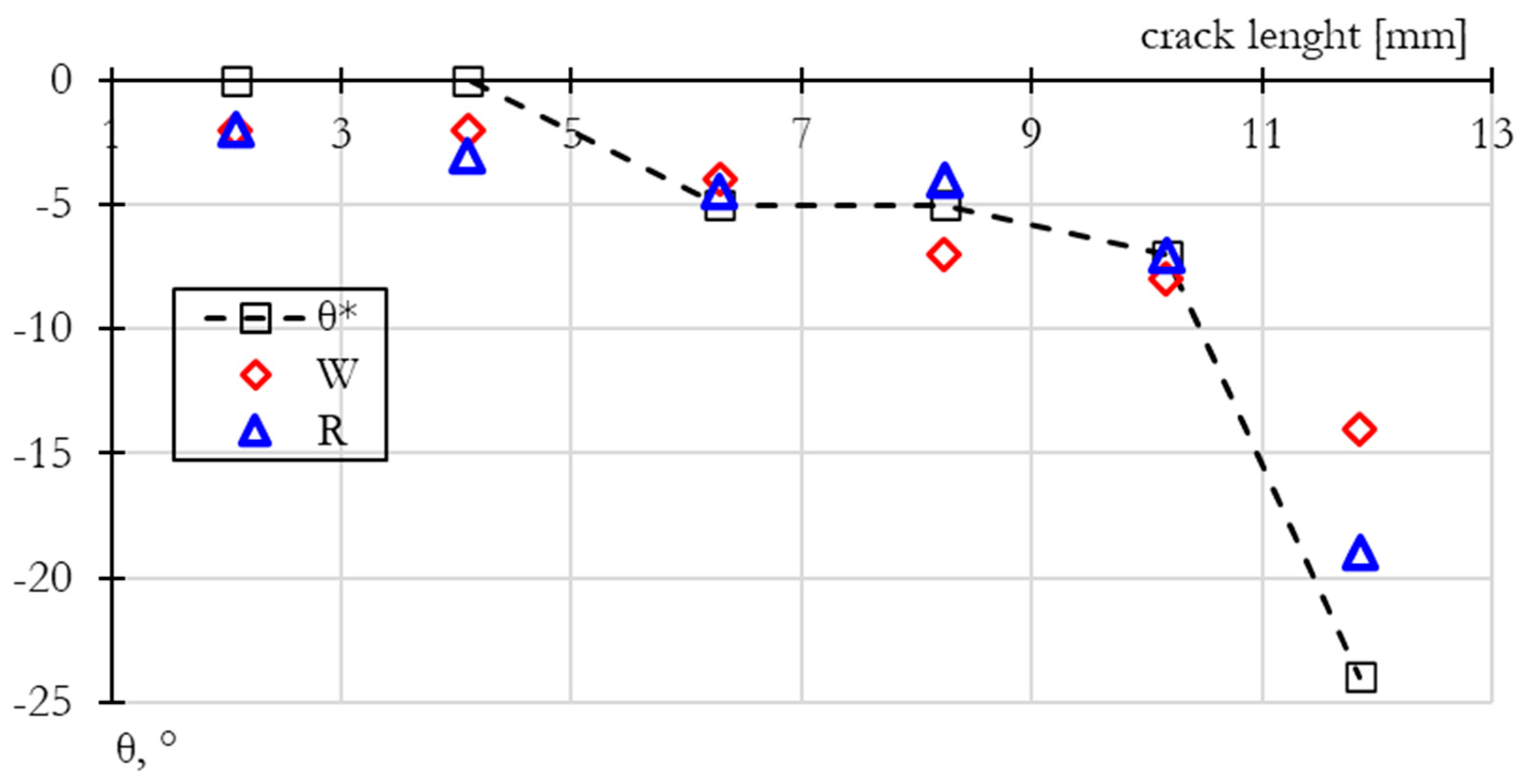
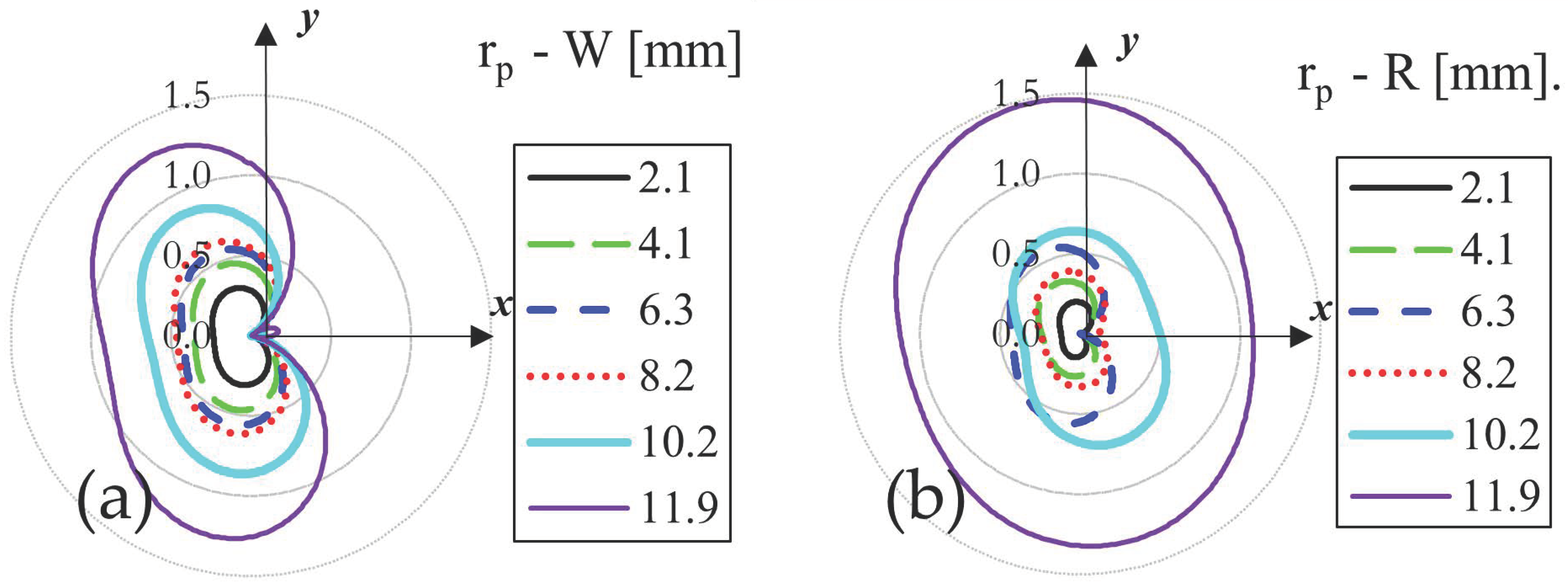
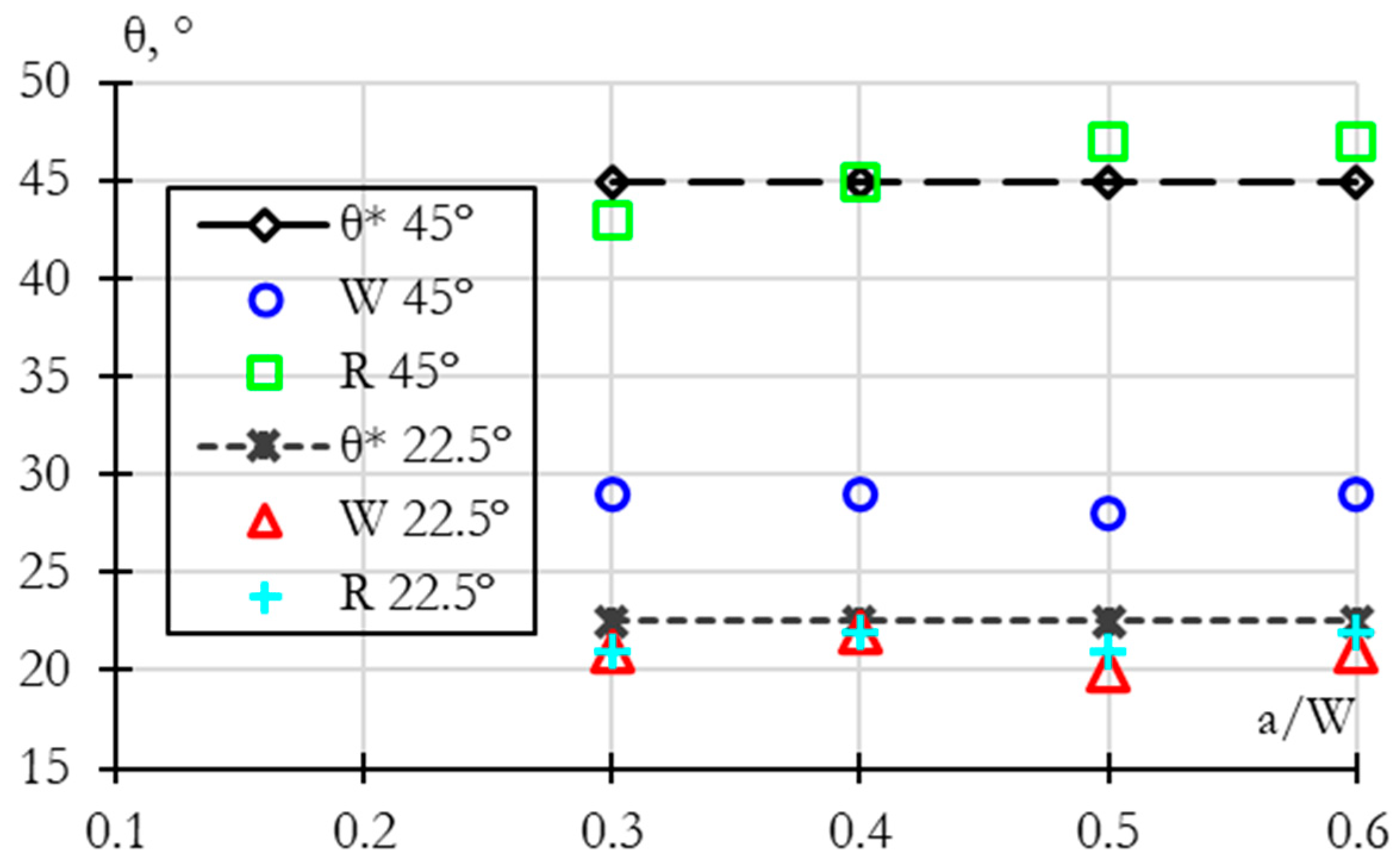
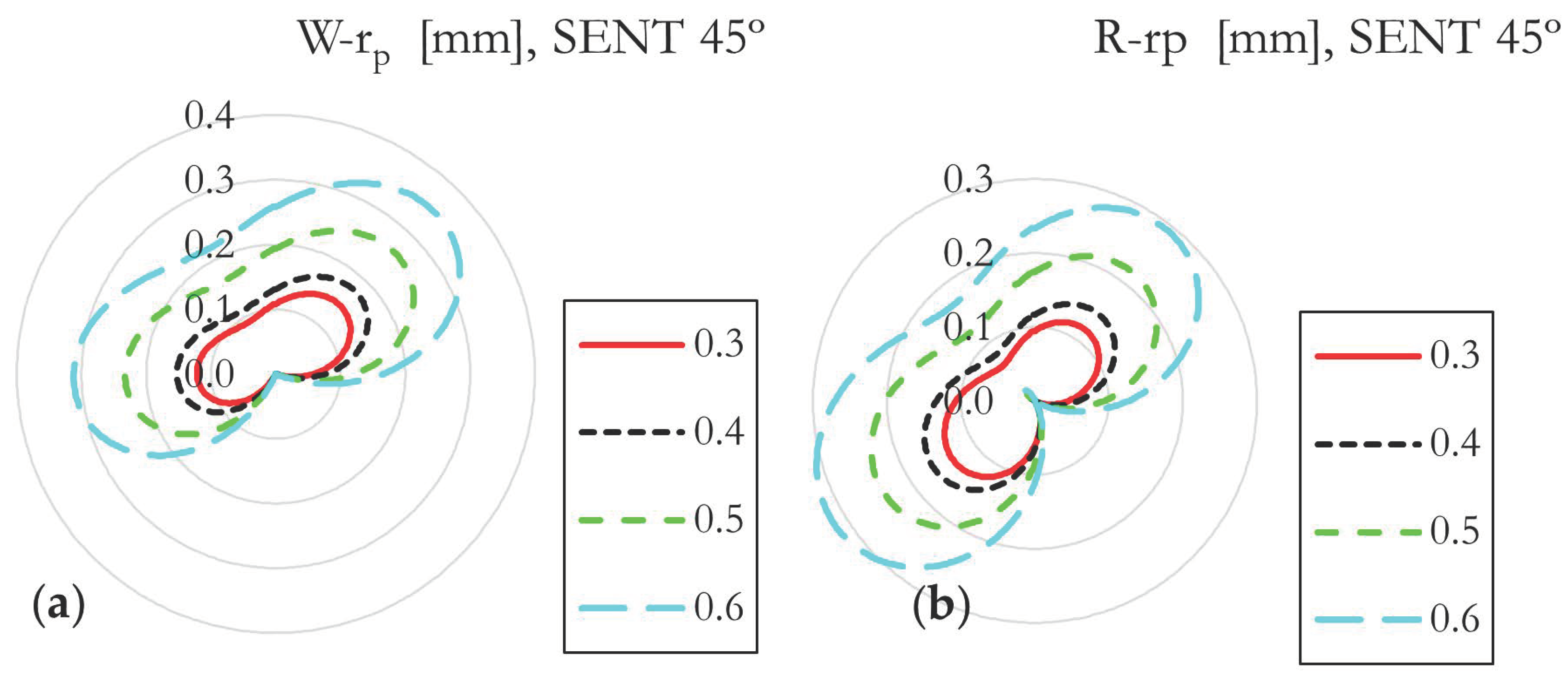

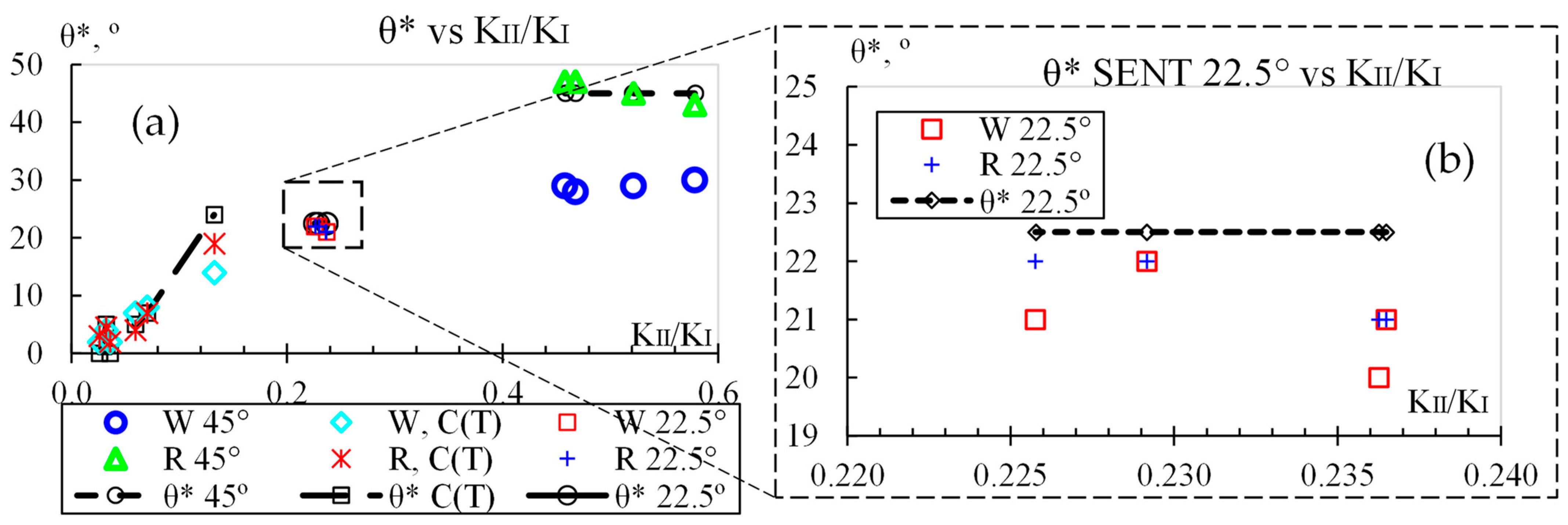
| Point | a [mm] | θ* | ΔKI, MPa√m | ΔKII, MPa√m | ΔKII/ΔKI |
|---|---|---|---|---|---|
| 0 | 2.1 | 0 | 13.12 | 0.46 | 0.04 |
| a | 4.1 | 0 | 17.78 | 0.47 | 0.03 |
| b | 6.3 | −5 | 18.14 | 0.59 | 0.03 |
| c | 8.2 | −5 | 19.67 | 1.17 | 0.06 |
| d | 10.2 | −7 | 22.00 | 1.55 | 0.07 |
| e | 11.9 | −24 | 26.85 | 3.55 | 0.13 |
| a/W | KI/(σ√πa) | KII/(σ√πa) | KII/KI |
|---|---|---|---|
| 45° | |||
| 0.3 | 0.83 | 0.48 | 0.58 |
| 0.4 | 0.96 | 0.50 | 0.52 |
| 0.5 | 1.22 | 0.57 | 0.47 |
| 0.6 | 1.42 | 0.65 | 0.46 |
| 22.5° | |||
| 0.3 | 1.48 | 0.35 | 0.24 |
| 0.4 | 1.80 | 0.41 | 0.23 |
| 0.5 | 2.28 | 0.54 | 0.24 |
| 0.6 | 2.99 | 0.68 | 0.23 |
| C(T) | SENT 45° | SENT 22.5° | ||||||
|---|---|---|---|---|---|---|---|---|
| ΔKII/ΔKI | W, C(T) | R, C(T) | ΔKII/ΔKI | W 45° | R 45° | ΔKII/ΔKI | R 22.5° | R 22.5° |
| 0.04 | −1.11 | −1.11 | 0.58 | 8.33 | 1.11 | 0.24 | 0.83 | 0.83 |
| 0.03 | −1.11 | −1.67 | 0.52 | 8.89 | 0.00 | 0.23 | 0.28 | 0.28 |
| 0.03 | 0.56 | 0.28 | 0.47 | 9.44 | −1.11 | 0.24 | 1.39 | 0.83 |
| 0.06 | −1.11 | 0.56 | 0.46 | 8.89 | −1.11 | 0.23 | 0.83 | 0.28 |
| 0.07 | −0.56 | 0.00 | ||||||
| 0.13 | 5.56 | 2.78 | ||||||
| Operator | +, −, ×, / | √ | Sin, Cos, Atan | Acos | Tan | ABS, SGN | ^ | Total Cost |
|---|---|---|---|---|---|---|---|---|
| Operator Cost | 2 | 2 | 5 | 4 | 6 | 2 | 8 | |
| Cost in W model | 23 | 0 | 10 | 0 | 0 | 0 | 10 | 176 |
| Cost in R model | 33 | 0 | 5 | 0 | 0 | 0 | 8 | 155 |
Disclaimer/Publisher’s Note: The statements, opinions and data contained in all publications are solely those of the individual author(s) and contributor(s) and not of MDPI and/or the editor(s). MDPI and/or the editor(s) disclaim responsibility for any injury to people or property resulting from any ideas, methods, instructions or products referred to in the content. |
© 2024 by the authors. Licensee MDPI, Basel, Switzerland. This article is an open access article distributed under the terms and conditions of the Creative Commons Attribution (CC BY) license (https://creativecommons.org/licenses/by/4.0/).
Share and Cite
Díaz-Rodríguez, J.G.; Pertúz-Comas, A.D.; Bohórquez-Becerra, O.R.; Braga, A.M.B.; Prada-Parra, D. Plastic Zone Radius Criteria for Crack Propagation Angle Evaluated with Experimentally Obtained Displacement Fields. Buildings 2024, 14, 495. https://doi.org/10.3390/buildings14020495
Díaz-Rodríguez JG, Pertúz-Comas AD, Bohórquez-Becerra OR, Braga AMB, Prada-Parra D. Plastic Zone Radius Criteria for Crack Propagation Angle Evaluated with Experimentally Obtained Displacement Fields. Buildings. 2024; 14(2):495. https://doi.org/10.3390/buildings14020495
Chicago/Turabian StyleDíaz-Rodríguez, Jorge Guillermo, Alberto David Pertúz-Comas, Oscar Rodolfo Bohórquez-Becerra, Arthur Martins Barbosa Braga, and Darío Prada-Parra. 2024. "Plastic Zone Radius Criteria for Crack Propagation Angle Evaluated with Experimentally Obtained Displacement Fields" Buildings 14, no. 2: 495. https://doi.org/10.3390/buildings14020495
APA StyleDíaz-Rodríguez, J. G., Pertúz-Comas, A. D., Bohórquez-Becerra, O. R., Braga, A. M. B., & Prada-Parra, D. (2024). Plastic Zone Radius Criteria for Crack Propagation Angle Evaluated with Experimentally Obtained Displacement Fields. Buildings, 14(2), 495. https://doi.org/10.3390/buildings14020495








